It’s best to think of the 2024 Porsche Cayenne as Cayenne version 3.5. It’s not a clean-sheet redesign, as its underlying crash structure, general dimensions and abundant componentry carrying over from the third-generation Cayenne launched for 2017. It’s more than the usual mid-cycle refresh, however.
Each of the four carryover models are more powerful (the GTS, Turbo and Turbo S E-Hybrid are on hiatus for 2024). The base Cayenne’s 3.0-liter turbo V6 now produces 348 horsepower and 368 pound-feet of torque, up 13 and 36, respectively. At the other end of the spectrum, the Cayenne Turbo GT’s 4.0-liter twin-turbo V8 now produces 650 hp, up from 631. It’ll hit 60 in the same 3.1 seconds. Changes to the two models in the middle are more substantial.
The Cayenne S loses its 3.0-liter twin-turbo V6 in favor of a 4.0-liter twin-turbo V8. You read that right. It’s hard to remember the last time a new vehicle received an increase in cylinders and displacement, rather than the opposite, but here we are. According to Stefan Fegg, director of the Cayenne model line, the V6 had reached the limits of its performance potential with the outgoing engine’s 434 hp and 405 lb-ft of torque. Porsche wanted to increase power for the quasi-new generation, however, which brought engineers back to the good-old V8 to achieve 468 hp and 442 lb-ft. Sounds simple enough, but to sell the Cayenne S in Europe, technologies had to be developed to accommodate strict emissions laws. These include innovative camshaft sensors, a higher-pressure injection system and an electric wastegate, and they also aid efficiency, though official EPA numbers were not available. Those aren’t found in the V8-powered Turbo GT, which subsequently isn’t for sale in Europe, Japan and elsewhere.
Frankly, if efficiency and emissions of a V8 can better, match or at least come close to those of a V6, who the hell is ever going to complain? The answer is no one. There was a reason we were so depressed as V8 after V8 got replaced by some characterless turbo V6 over the course of a decade-plus. Porsche/Audi’s V6s were better than most, but there’s still no replacing the telltale warble produced by those extra cylinders. While we await the all-new, all-electric Cayenne generation that’ll arrive in the “middle of the decade” and be sold alongside this generation-and-a-half for some amount of time, it’s nice to know the gas-powered Cayenne will go down swinging.
That said, choosing it isn’t a given. The Cayenne E-Hybrid gets that updated base V6 plus a more powerful electric motor for a total system output of 463 hp, up from 455. It hits 60 in 4.7 seconds, which is only three tenths off the pace of the V8. The bigger news is the battery, which significantly expands from 17.9 kilowatt-hours up to 25.9. EPA electric-only range estimates were not available, but the car showed 45 miles when we got in with a full battery – that would be a massive improvement over the previous 17 miles. Either way, there’s a new, more powerful, 11-kW AC charger on board, which can drop at-home charging times to as little as 2½ hours with the right home charger.
Acceleration from the E-Hybrid is unsurprisingly quiet and smooth when driving using the all-electric range. Different hybrid power source combinations automatically pop up in the touchscreen when you operate the steering wheel rotary drive mode knob, including automatic, hold (saves the current battery amount for later in your drive) and charge (uses the engine to top up the battery for later in your drive). By contrast, doing so in a Volvo Recharge model requires tap-tap-tapping into the touchscreen.
Again, though, the E-Hybrid isn’t just the eco choice. It may be a hair slower to 60 and lack that signature V8 warble, but it’s absolutely a performance-oriented powertrain. It was a pleasure to wring out in the Santa Monica Mountains, with the electric motor ever ready to provide a jolt of right-now torque as the boosted six spools into action with a not-unforgettable engine and exhaust note. The overall experience driving the S wasn’t so much better that it would outweigh the E-Hybrid’s ample electric range and lower price – $91,700 versus $95,700 for the SUV with the Coupe costing another $4,000 (E-Hybrid) or $6,400 (S).
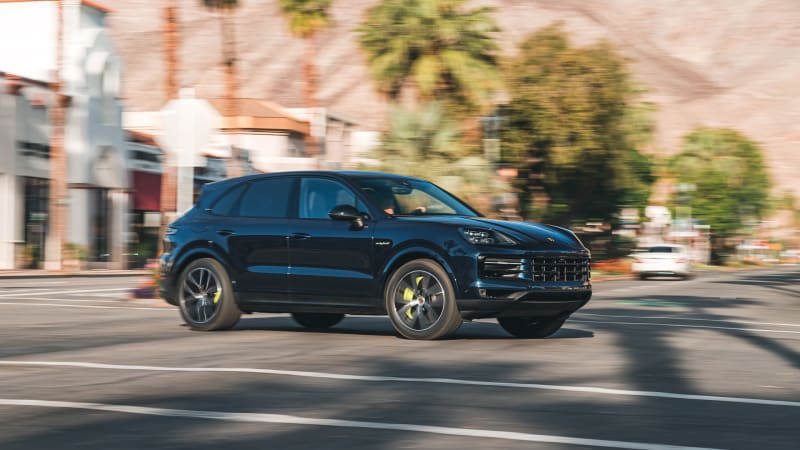
One possible hangup: the brake pedal. The E-Hybrid has the same firm initial pedal response as other Cayenne models do, but for whatever reason, this leads to some clunky transitions between the regenerative and mechanical brakes that makes for difficult modulation and jerky stops, especially at lower speeds. Perhaps this could be attributed to our E-Hybrid test car having the carbon ceramic brake option, which seems utterly nonsensical for this particular Cayenne (if possibly every Cayenne). Something to look out for on a test drive.
All 2024 Cayennes other than the Turbo GT get a revised Porsche Active Suspension Management (PASM) system with steel springs and new two-valve shock absorbers replacing the previous single valve setup. Basically, one valve handles rebound and the other compression, thereby improving the suspension’s handling composure and ride comfort. Our test cars had the optional adaptive air suspension (standard on the Turbo GT) that features a new two-air-chamber, two-valve design that does an even greater job of the same overall mission, while also providing a greater differentiation between the Normal, Sport and Sport Plus driving modes. The aforementioned wringing out in the Santa Monica mountains certainly confirmed the handling composure bit, while ride comfort was impeccable during our trip up and down Highway 101 from Malibu to Ojai, Calif.
Another option sampled was the rear-wheel-steering system, which responds quicker than before. While having RWS in a large sedan or sports car is now commonplace, the feeling of the rear-end coming around so sharply in such a tall vehicle is strange if impressive.
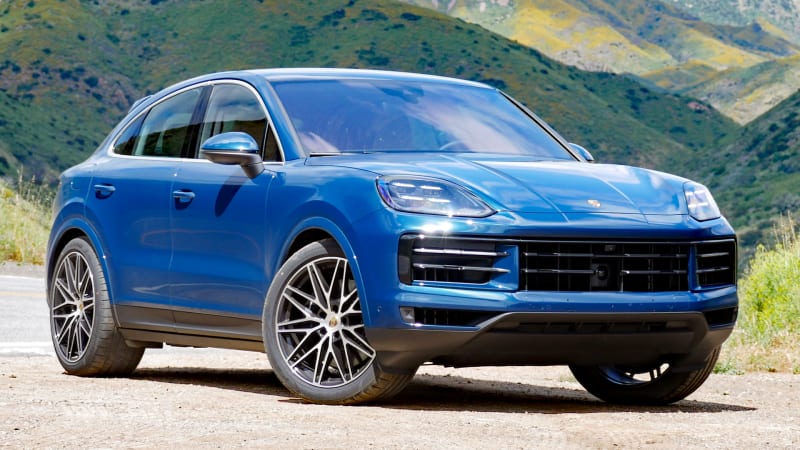
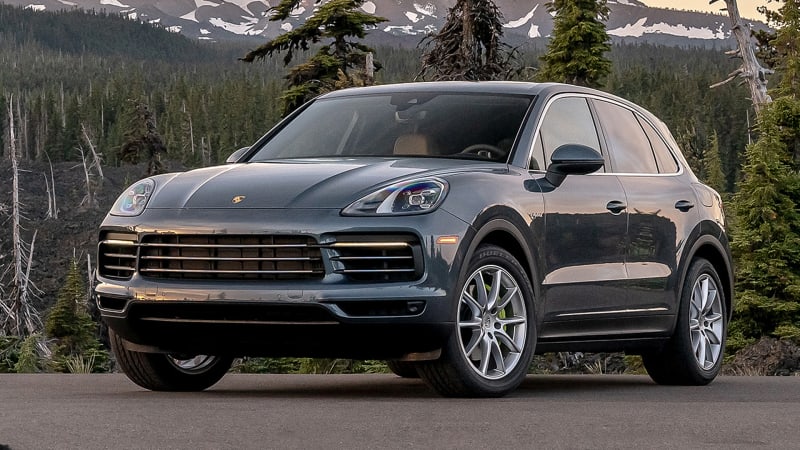
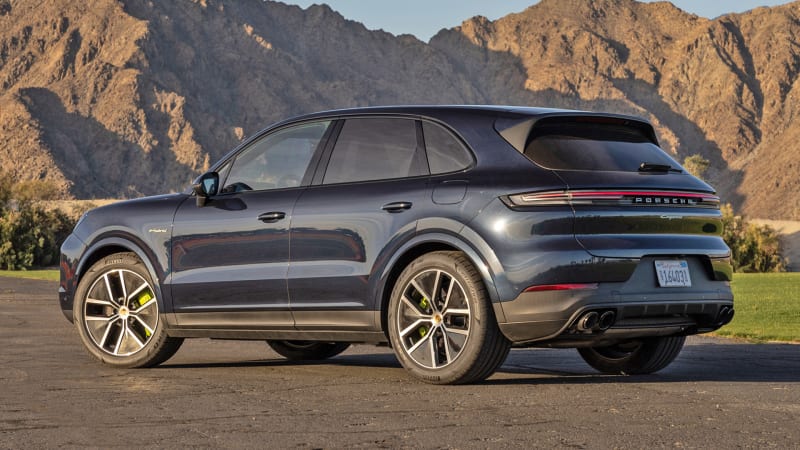
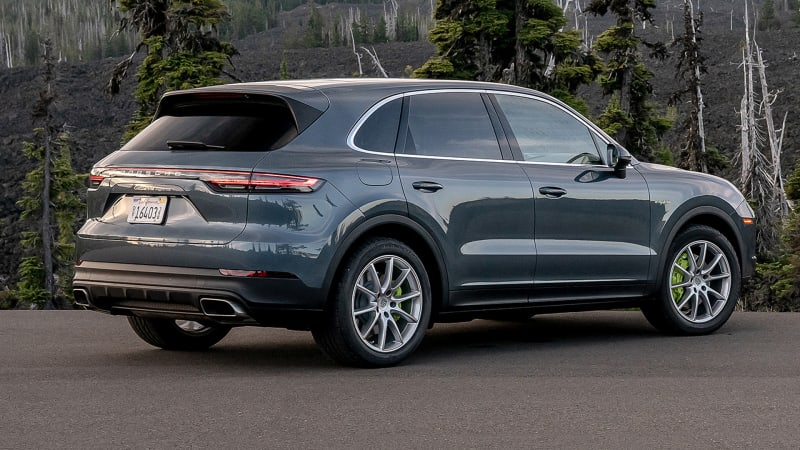
The exterior is updated, but in true Porsche fashion, it’s hard to tell unless you’re looking at them side by side. So, go ahead and do that above. The gray cars are the previous design.
The interior is a much bigger deal as it not only represents a fresh design for the Cayenne, but debuts components fresh for Porsche. The instrument panel is now all-digital and includes seven layout/design options, but all are in keeping with Porsche’s existing gauge aesthetic (i.e., don’t expect futuristic graphics or whatever BMW thinks it’s doing). That includes a traditional five-gauge layout, but the information presented isn’t further customizable, which means you’re stuck with both a silly G meter and a rarely needed tire-pressure monitor.
The new climate controls are clearly a response to complaints about Porsche’s previous two climate control concepts (way too many buttons interspersed amongst unrelated buttons followed by fewer, but now-difficult-to-find touch-sensitive “buttons”). The new concept is a neat row of physical toggles bordered above and below by touch-sensitive icons. It’s a better concept, but the execution is flawed. Pushing down on the icons provides haptic feedback, but the entire black trim piece moves with each “button” push, which comes across as cheap, especially for a Porsche. The controls are ultimately easier to use without looking, though, so we’ll log it as a win. The Cayenne also does without the Panamera and Taycan’s ridiculous touchscreen-controlled air vents – don’t expect other future Porsches to have them.
There’s no free interior packaging lunches, though, so to make room for that neat array of climate controls on the center console, the old monostable shift knob was binned in favor of the Taycan’s dash-mounted toggle shifter. It’s weird in design and placement, but like most electronic shifters, you’re bound to get used to it.
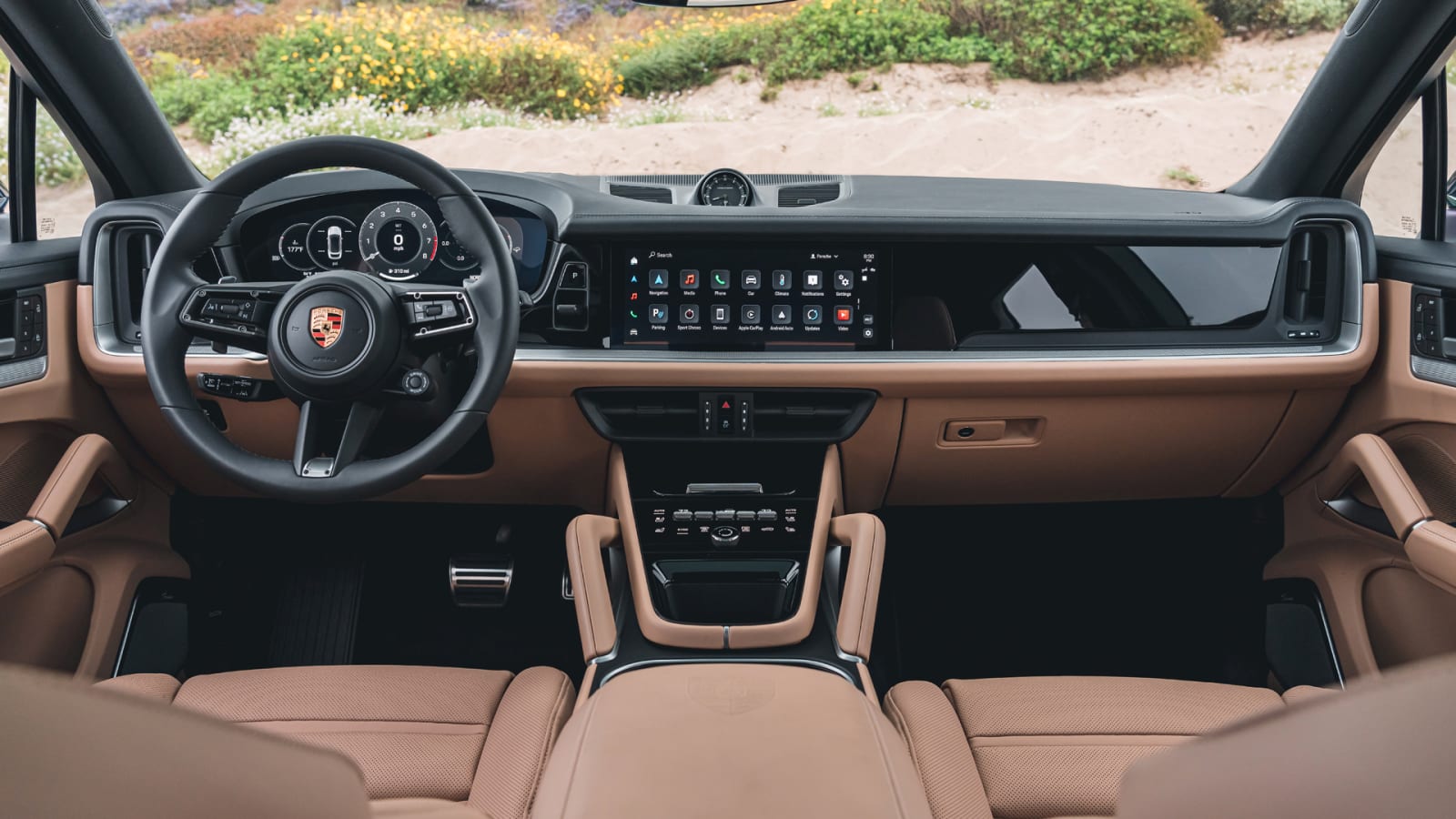
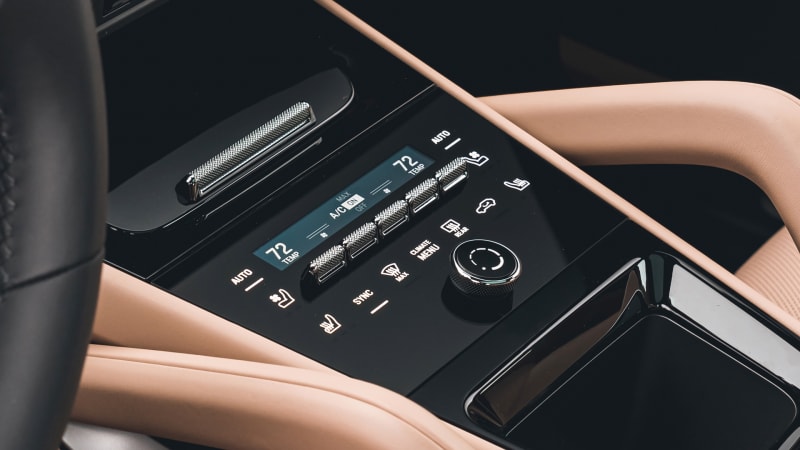
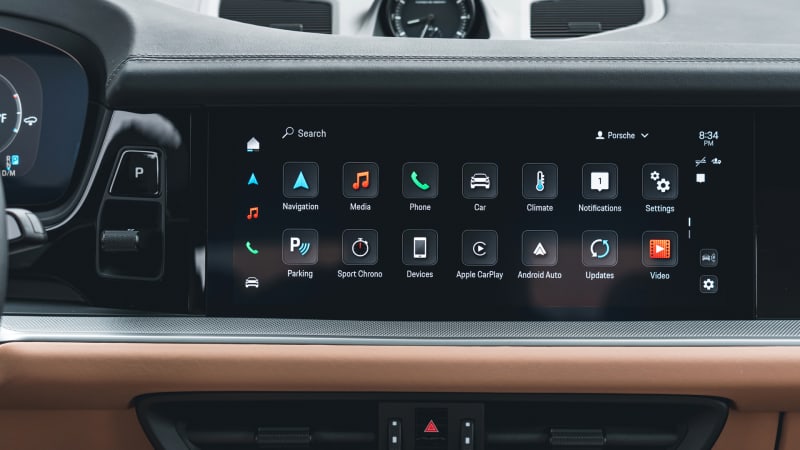
To the right of it sits the latest Porsche Communication Management (PCM) infotainment system, already found in the Taycan, 911 and Panamera. The system is more colorful than the Cayenne’s previous PCM, with icons easier to differentiate at a glance, but it’s mostly similar in overall UI concept. That includes the column of menu icons permanently docked on the left side of the standard 12.3-inch touchscreen, including one to quickly engage and exit Apple CarPlay.
Sadly not present in our test car was the new, optional 10.9-inch passenger display. Not unlike the one offered in the Taycan, this touchscreen allows the passenger to operate the navigation system or watch streaming video (from something called Screenhits TV), while a polarized filter ensures that the driver cannot see what’s shown. Having the in-dash TV might be nice, but in our past experience, focusing too much on other touchscreen controls, especially during more sporting moments of driving, is a recipe for, well, barfing.
Other tech upgrades include USB-C ports all-around and a powerful, 15-watt smartphone wireless charger that’s cooled to prevent your phone from incinerating. The optional adaptive cruise control system now has an Evasion Assist system that aids the driver with steering and braking support at speeds between 31 and 93 mph. It also includes a new Turn Assist function that prevents you from turning left when a potential collision with an oncoming car is detected.
The final interior piece is the 911’s multifunction sport steering wheel that includes the rotary drive mode switch and a dedicated toggle button for selecting functions for both the IP and available head-up display. No touchscreen diving needed.
All told, the 2024 Cayenne does not amount to a massive difference from the car it replaces, but that probably would’ve been the case had it been a clean-sheet redo. This is Porsche we’re talking about, the epitome of automotive evolution over revolution. Most people probably couldn’t tell a 2010 Boxster or 911 apart from a brand-new one. Of course, when the actual fourth-generation Cayenne debuts with its all-electric powertrain, now that will be a revolution.
Related Video:
